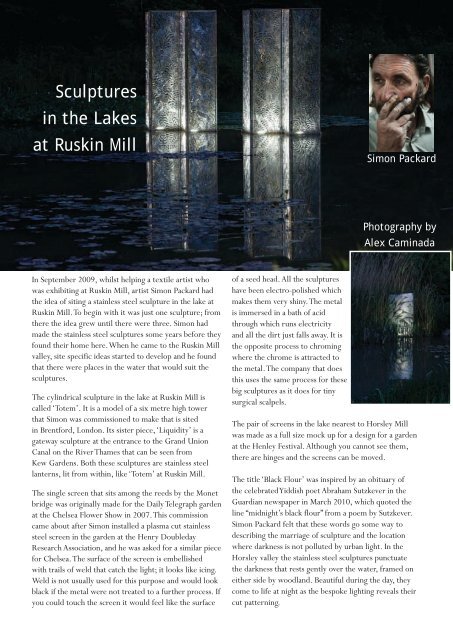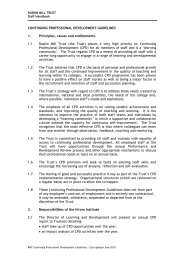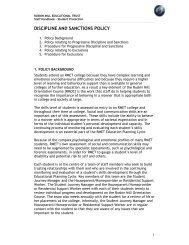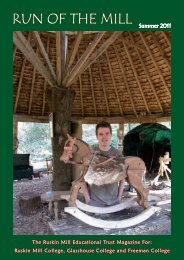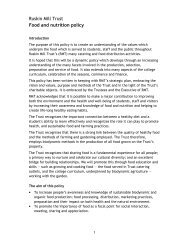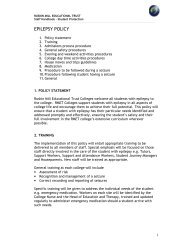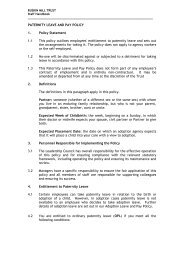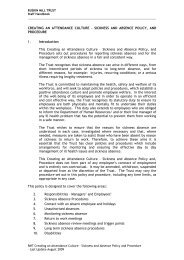RUN OF THE MILL - Ruskin Mill Trust
RUN OF THE MILL - Ruskin Mill Trust
RUN OF THE MILL - Ruskin Mill Trust
Create successful ePaper yourself
Turn your PDF publications into a flip-book with our unique Google optimized e-Paper software.
Sculptures<br />
in the Lakes<br />
at <strong>Ruskin</strong> <strong>Mill</strong><br />
In September 2009, whilst helping a textile artist who<br />
was exhibiting at <strong>Ruskin</strong> <strong>Mill</strong>, artist Simon Packard had<br />
the idea of siting a stainless steel sculpture in the lake at<br />
<strong>Ruskin</strong> <strong>Mill</strong>. To begin with it was just one sculpture; from<br />
there the idea grew until there were three. Simon had<br />
made the stainless steel sculptures some years before they<br />
found their home here. When he came to the <strong>Ruskin</strong> <strong>Mill</strong><br />
valley, site specific ideas started to develop and he found<br />
that there were places in the water that would suit the<br />
sculptures.<br />
The cylindrical sculpture in the lake at <strong>Ruskin</strong> <strong>Mill</strong> is<br />
called ‘Totem’. It is a model of a six metre high tower<br />
that Simon was commissioned to make that is sited<br />
in Brentford, London. Its sister piece, ‘Liquidity’ is a<br />
gateway sculpture at the entrance to the Grand Union<br />
Canal on the River Thames that can be seen from<br />
Kew Gardens. Both these sculptures are stainless steel<br />
lanterns, lit from within, like ‘Totem’ at <strong>Ruskin</strong> <strong>Mill</strong>.<br />
The single screen that sits among the reeds by the Monet<br />
bridge was originally made for the Daily Telegraph garden<br />
at the Chelsea Flower Show in 2007. This commission<br />
came about after Simon installed a plasma cut stainless<br />
steel screen in the garden at the Henry Doubleday<br />
Research Association, and he was asked for a similar piece<br />
for Chelsea. The surface of the screen is embellished<br />
with trails of weld that catch the light; it looks like icing.<br />
Weld is not usually used for this purpose and would look<br />
black if the metal were not treated to a further process. If<br />
you could touch the screen it would feel like the surface<br />
of a seed head. All the sculptures<br />
have been electro-polished which<br />
makes them very shiny. The metal<br />
is immersed in a bath of acid<br />
through which runs electricity<br />
and all the dirt just falls away. It is<br />
the opposite process to chroming<br />
where the chrome is attracted to<br />
the metal. The company that does<br />
this uses the same process for these<br />
big sculptures as it does for tiny<br />
surgical scalpels.<br />
Simon Packard<br />
Photography by<br />
Alex Caminada<br />
The pair of screens in the lake nearest to Horsley <strong>Mill</strong><br />
was made as a full size mock up for a design for a garden<br />
at the Henley Festival. Although you cannot see them,<br />
there are hinges and the screens can be moved.<br />
The title ‘Black Flour’ was inspired by an obituary of<br />
the celebrated Yiddish poet Abraham Sutzkever in the<br />
Guardian newspaper in March 2010, which quoted the<br />
line “midnight’s black flour” from a poem by Sutzkever.<br />
Simon Packard felt that these words go some way to<br />
describing the marriage of sculpture and the location<br />
where darkness is not polluted by urban light. In the<br />
Horsley valley the stainless steel sculptures punctuate<br />
the darkness that rests gently over the water, framed on<br />
either side by woodland. Beautiful during the day, they<br />
come to life at night as the bespoke lighting reveals their<br />
cut patterning.


